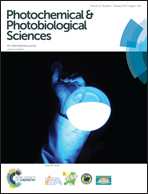The influence of Pluronics nanovehicles on dark cytotoxicity, photocytotoxicity and localization of four model photosensitizers in cancer cells†
Abstract
Many photosensitizers (PSs) for use in photodynamic therapy (PDT) are characterized by poor solubility and a tendency to aggregate in aqueous environments. Nanovehicles of Pluronics block copolymers may be used for drug delivery of antineoplastic agents and may also exert a separate effect in enhancing drug efficiency. The objective of this study was to determine the effects of selected Pluronics (F127, P123, L44 and F68) on the dark cytotoxicity, photocytotoxicity and localization of four model photosensitizers, tetraphenyl porphyrins 4-substituted on the phenyl groups with trimethylamine (TAPP), hydroxyl (THPP), sulfonate (TSPP) and carboxyl (TCPP) in cancer cells. The selected PSs showed a 3 log range in sensitivity to cellular photoinactivation. Pluronics were found to efficiently deaggregate the PSs and improve PS solubility as analyzed by fluorescence spectroscopy and dynamic light scattering. The Pluronics had moderate to profound effects on intracellular localization of the PSs and cellular sensitivity to photoinactivation. Confocal microscopy was used to determine the localization of PSs in colon adenocarcinoma cell line (WiDr), guided by co-staining with nuclear (Hoechst 33342) and endolysosomal (LysoTracker Green DND® 26 and Dextran Alexa Fluor® 488) markers. Of the most significant effects P123 and F127 strongly attenuated the uptake and photocytotoxicity of THPP and redirected the cellular uptake to endocytosis. P123 stimulated translocation of TAPP from endocytic vesicles to a cytosolic and nuclear localization followed by an enhanced phototoxicity. In the absence of Pluronics TCPP was found to localize partly in endocytic vesicles and partly in the cytosol and nucleus, while P123 and F127 lowered the fraction in endocytic vesicles followed by a reduced sensitivity to photoinactivation. F68 had only moderate effects on intracellular localization of the evaluated PSs with the exception of a higher endocytic accumulation of TCPP and lowered photocytotoxicity of TCPP and THPP. In conclusion, Pluronics are attractive solubilizers of porphyrin-based PSs which have in many cases substantial effects on intracellular localization and efficacy of the PSs.


 Please wait while we load your content...
Please wait while we load your content...